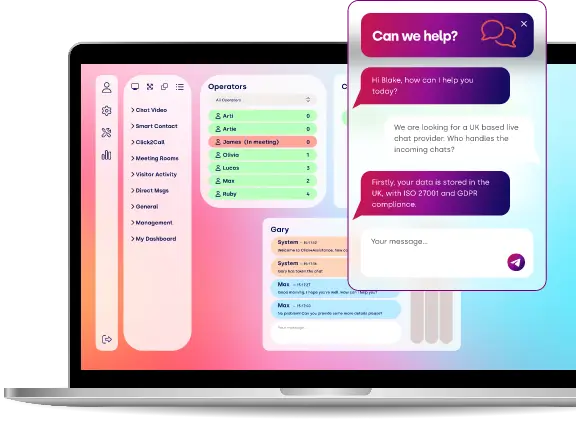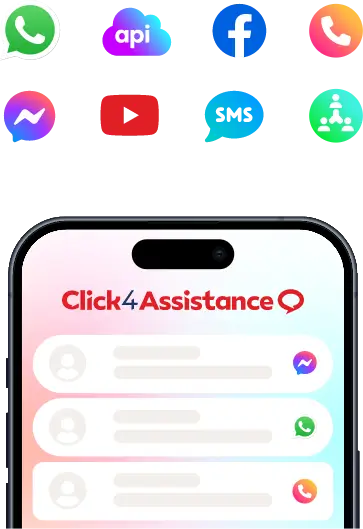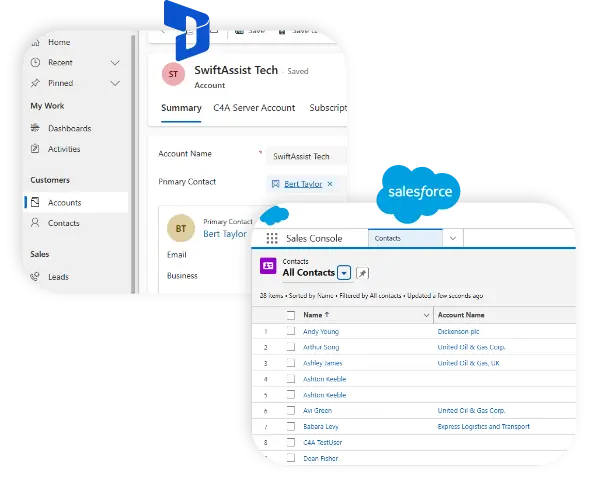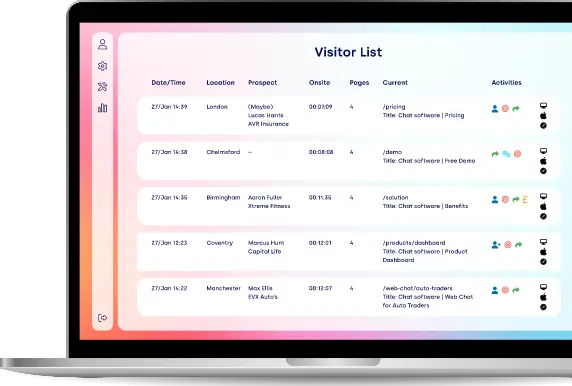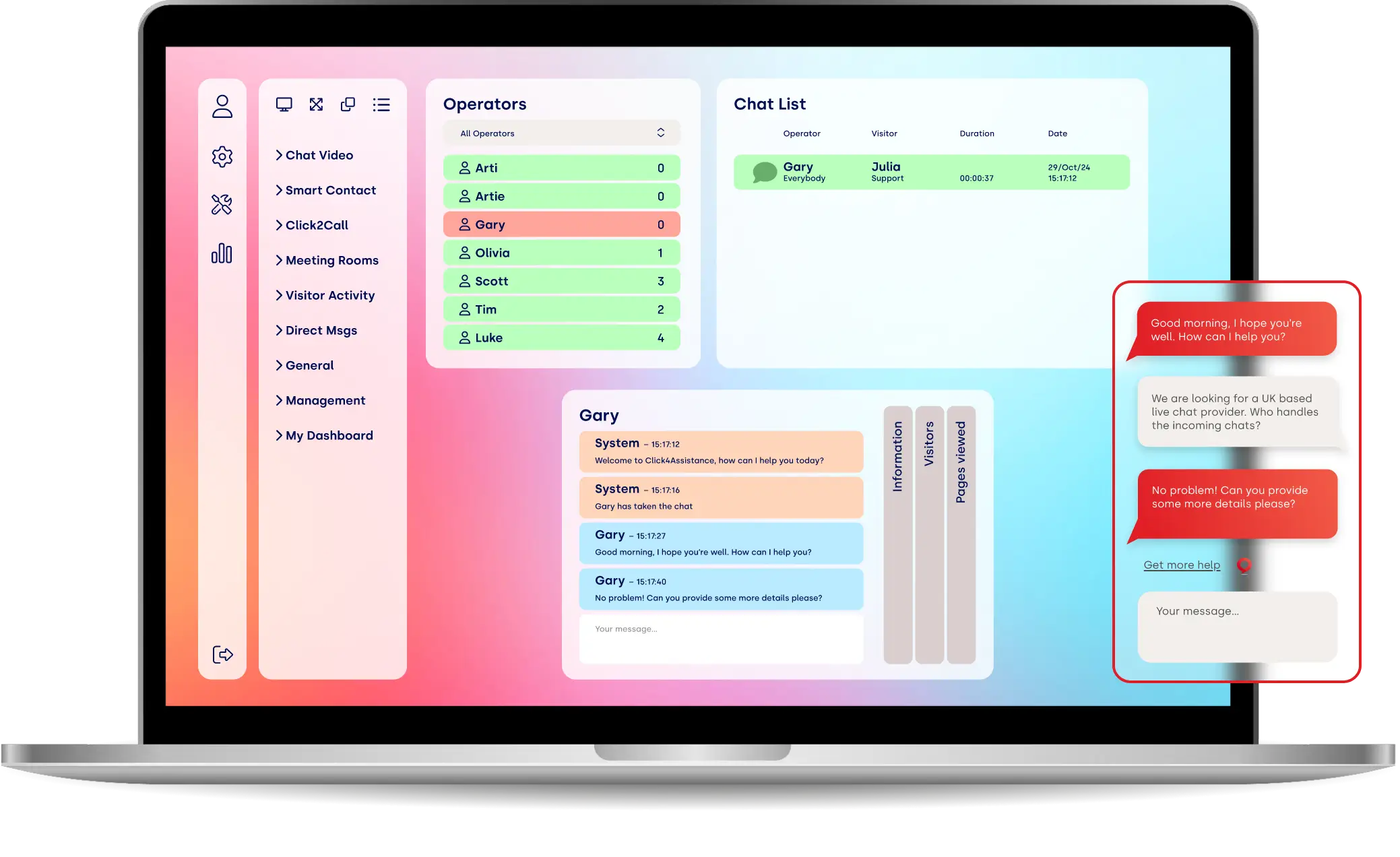Top 10 common chatbot mistakes and how to avoid them

Want to add live chat and chatbot to your website? Read this guide to the most common mistakes and how to avoid them first.
Introduction
Chatbots offer an array of benefits to business owners, entrepreneurs and executives, but they’re not always guaranteed to skyrocket sales or improve customer experience. If you get it right, you can reap the rewards of adding live chat to your website, but there are pitfalls. Data from 2024 suggests that around 37% of companies now use chatbots, with over 25% of sales originating from live chat interactions. There’s scope to enhance your website and maximise the efficiency and efficacy of customer service but it’s essential to know how to use chatbots and what not to do.
In this detailed guide, we’ll outline some common chatbot mistakes and share tips and advice to help you avoid them.
Common chatbot mistakes and tips to avoid them
The arrival of chatbots has transformed the way businesses provide customer service and support and revolutionised the customer experience. If you add live chat to your website, there are several amazing advantages but it’s crucial to be aware of common mistakes. Just as using chatbots correctly can supercharge results and outcomes, making the wrong decisions can have devastating consequences. To help you streamline the process and capitalise on the incredible benefits of chatbots, here are the top 10 most common chatbot errors and tips to help you avoid them:
1. Failing to implement a chatbot strategy
Chatbots have become increasingly commonplace in the last few years, with almost 40% of businesses using them in 2024. Trends often influence decision-making, but it’s important to have a customised strategy if you plan to use chatbots on your website. If you fail to plan, or you don’t have clear objectives, you run the risk of wasting money on a service that won’t help you hit targets, solve problems or achieve goals.
Before you begin, think about why you want to use chatbots, what purpose they will serve your business and how you’ll incorporate them. Chatbots can be used for diverse purposes, from creating more leads to responding to customer queries rapidly. Tailor your chatbot strategy to your needs and requirements and the preferences of your target customer base.
As a business owner or executive, it’s wise to communicate with your team to determine the best uses for chatbot services. If you’re unable to handle calls or emails due to high volumes or a lack of human resources, for example, chatbots could help you improve customer satisfaction rates and drastically reduce response times. Statistics from MIT Technology Review show that 90% of companies experience swifter complaint resolution after adopting chatbots.
2. A lack of personality
In many cases, businesses use chatbots to engage with customers and accelerate customer service and support processes. Chatbots can add to or replace teams, providing a point of contact for clients. To succeed, it’s important to have personality. Drab, mundane interactions could drive customers away and give competitors an advantage.
When drawing up a strategy for your business, take inspiration from companies and brands that are known for using chatbots and voice-activated devices and software effectively. Examples include Apple’s Siri and Amazon’s Alexa. People are familiar with these names, they use them regularly and they associate them with quick, smart responses and consistency in terms of the tone of voice and level of courtesy and politeness. Although chatbots are not people, they should be personable and encourage customers and web users to engage and interact.
Steps to humanise your chatbot and create positive relationships include:
- Give your chatbot a name
- Start every conversation with a brief, polite introduction
- Address the customer by name
- Embrace AI and natural language processing technology to replicate human interactions
- Add a company logo
3. A lack of testing
Testing is beneficial across all sales and marketing interactions. It can make the difference between success and failure and save businesses a huge amount of time and money. A lack of testing during the planning process can hamper progress and efficacy when you launch your chatbot feature. Testing in advance enables you to monitor performance levels, highlight pain points and weaknesses and identify areas for improvement. Trials and demos can also give you valuable information about your chatbot’s limitations and the scenarios in which it shines or struggles.
Using data, feedback and customer insights to adapt and improve your strategy will reduce the risk of errors and help you take full advantage of the perks and benefits of using a chatbot service.
4. Assuming everyone already uses chatbots
If you’re a regular web or app user, you may be familiar with chatbots, but they’re not a feature of everyday life for everyone. When you add a chatbot, it’s essential to recognise that some people may be using this type of service for the first time. Many customers who use chatbots are doing so with no previous experience of live chat. They may not know how to communicate, what to do or what to expect. It’s critical to ensure that your chatbot service is easy and convenient to use. Issue clear instructions, provide a step-by-step process, engage with the customer and offer updates during the conversation.
5. Not providing a quick exit route
One of the top reasons why chatbots and live chat are so popular is the speed of interaction. Many customers now prefer to open a chat box rather than call, email or enquire via a website or social media. Providing instant or speedy access to customer service and support is great, but it’s vital to consider the exit point too. As a customer, you don’t want to feel that you have nowhere to go if you’ve got the answers you need or you’ve run out of time and you need to leave the chat. Providing a quick, obvious exit route enhances customer experience and eliminates frustration.
To help you avoid this problem, here are some simple steps:
- Add a large X button to the top or bottom corner of the chat
- Make sure the exit button stands out
- Make it as quick and easy to end the chat as possible
- Provide signposting via buttons or links to help the user take the next steps
6. Failing to understand the importance of human customer service
Chatbots can have an incredibly positive impact on customer service and support, but they have limitations. One of the most fundamental errors business owners can make when using live chat is failing to understand the importance of human customer service. Chatbots are brilliant for solving basic problems, answering simple questions and providing access to 24-hour support, but they shouldn’t be seen as a replacement for a dedicated customer service department or team. There are issues that a chatbot can’t solve and cases where customers need to speak to a person at the end of a phone line or email trail.
Chatbots are a popular form of communication for web users, but in certain scenarios, interacting with a human being is preferable. Data published by Forbes suggests that 75% of customers believe that chatbots can’t handle complicated queries while 64% said they had experienced frustration when dealing with a chatbot.
As part of your chatbot strategy and testing process, it’s beneficial to highlight situations that are not suitable for chatbots and put alternative measures in place. It’s common for companies to escalate certain questions, cases or complaints to trained advisers, for example. If you don’t intervene or offer other forms of support, the customer may get frustrated or angry, they might leave the chat and try another channel, or they may even leave your business altogether and choose a competitor. Studies indicate that 30% of people would abandon their cart, choose another brand or business or leave negative feedback after one bad experience with a chatbot.
7. Choosing the wrong chatbot for your business
There are multiple options to consider when choosing a chatbot. It’s difficult to answer questions like, ‘Which is the best chatbot?’ because every company has different requirements and preferences. What works for one business may not be the best choice for another. To make the right decision, you need to think about what you want your chatbot to do, how you plan to use it and what kinds of features you want or require. Answering these key questions will help you narrow the options to find the right tool for your website.
Analysing features and comparing chatbots and prices is beneficial when deciding which chatbot to use. If you only need a basic service to handle simple questions about placing an order, for example, you don’t want to waste money on a service with all the bells and whistles. Likewise, if you have grand plans for your chatbot to deliver advanced features, you don’t want to offer a basic service that won’t cater to your customer’s needs.
8. Not using analytics
Analytics play a pivotal role in developing and adapting chatbot strategies to ensure they work effectively. Collecting and analysing data gives you valuable information to make decisions and tweak your strategy. You can use data to identify pain points, carry out continuous performance monitoring, test new ideas and gauge customer feedback. You can also modify your chatbot and refine it to make sure it delivers the services and benefits you desire.
To use analytics successfully, it’s critical to establish key metrics that align with your business objectives and chatbot strategies. These may include:
- The number of interactions
- Lead creation and conversion
- Hand-off rate to customer support agents or advisers
- Error messages
- Customer satisfaction scores
- The number of invitations to engage with the bot
9. Providing the wrong amount of information
One of the most common frustrations for customers who use chatbots is being bombarded with information or finding themselves asking the same question repeatedly due to a lack of information. To use a chatbot successfully on your website, it’s crucial to provide the right amount of information. If your chatbot launches into a lengthy spiel, which spans several lines at the start of the conversation, the customer may lose interest and close the chat. At the other end of the spectrum, you may lose the user if your chatbot doesn’t offer enough information, leaving the customer with more questions and queries.
It can be difficult to gauge an appropriate level. You want to keep your customer engaged and interested while ensuring you don’t bore or overwhelm them. To help you find the right balance, here are some tips:
- Keep your greeting short and succinct but provide clear instructions
- Break longer messages into short sentences and paragraphs
- Be mindful of the length of each message
- Focus on finding a quick resolution
- Offer easy access to helpful steps, such as links to the relevant pages or products, access to FAQS and contact details and buttons to call an agent or arrange a callback
10. Being too salesy
Most people respond negatively to overly aggressive, in-your-face sales tactics when shopping in-store or browsing products in a showroom. The same trend is visible across chatbot interactions. If a chatbot is too salesy and pushy, it can drive customers in the opposite direction. If your chatbot goes in too heavy at the start of the chat, or it pesters customers to buy, subscribe or make a call, this can be counterproductive.
To prevent this common chatbot error, your chatbot should be welcoming, polite and respectful. Simple things like adding a greeting, introducing the chatbot by name and asking how the person is doing today can set the right tone from the outset, increasing the chances of a positive experience.
Best practice guidelines: Quick tips
Here are some quick tips to help you avoid common chatbot mistakes:
- Create a tailored, customised strategy that aligns with your business objectives and the needs and preferences of your target audience
- Test before you launch
- Create a polite, personable chatbot
- Choose the right chatbot based on your needs, goals and budget
- Use analytics to make improvements and modifications
- Escalate complex issues and cases to support agents and advisers
- Monitor performance levels continuously
- Aim for succinct exchanges: Try to avoid providing too much or too little information
- Understand that chatbots can’t replace humans in many scenarios
Conclusion
Chatbots have revolutionised the way we interact with businesses and the way companies handle queries and provide customer service and support. There are multiple benefits to using a chatbot but if you want to add live chat to your website, it’s crucial to be aware of common mistakes. Avoiding errors and pitfalls can help you reap the rewards of effective, targeted chatbot strategies while elevating customer service and experience and increasing the chances of achieving business goals. Common mistakes include failing to implement a tailored strategy, choosing the wrong type of chatbot, not using analytics, being too salesy and pushy and not providing further support from human agents for complex questions. Additional errors include failing to test chatbots before the launch, providing the wrong amount of information and not offering a quick, obvious exit route.
If you’re interested in live chat for your website, or you have questions about the incredible benefits of chatbots, don’t hesitate to get in touch with the Click4Assistance team.
